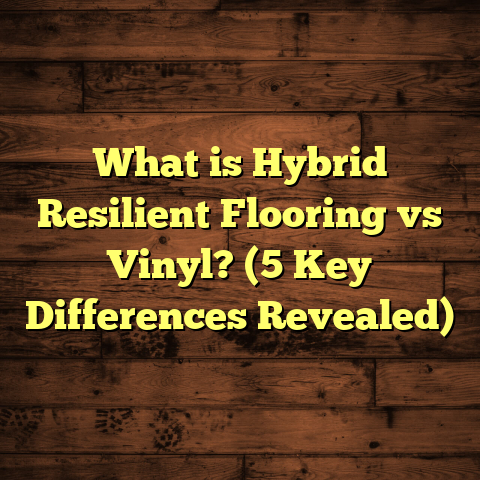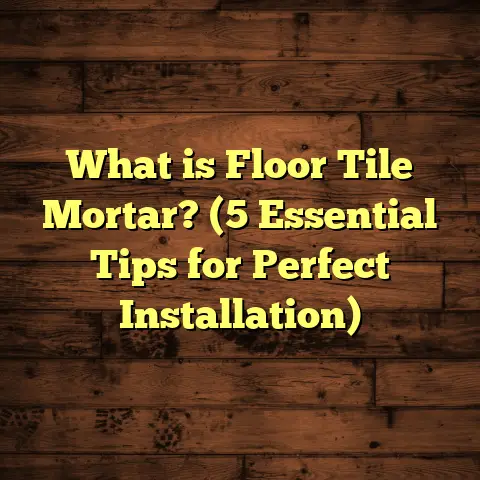What is a Linear Foot in Laminate Flooring? (5 Key Facts Explained)
Modern aesthetics have transformed the way we think about home interiors, especially when it comes to flooring. The sleek, clean look of laminate flooring has become a favorite for many homeowners, including myself. Over the years, I’ve installed dozens of laminate floors and helped countless clients choose the right materials. But one thing that always comes up early in the project planning stage is understanding measurement terms—especially the “linear foot.” So, what exactly is a linear foot in laminate flooring? How does it differ from square footage? Why should you care? I’ll take you through everything I’ve learned on this topic and share some tips that have saved me time and money along the way.
What Is a Linear Foot in Laminate Flooring?
Let’s start with the basics: A linear foot is a simple measurement of length. It means exactly one foot measured along a straight line. In laminate flooring, this measurement helps us figure out how much material we need to buy, especially because flooring planks come in fixed lengths.
Now, you might be thinking: “Isn’t flooring usually measured in square feet?” You’re right—square footage is how we usually think about floor area. Square footage measures two dimensions: length times width. But linear footage focuses only on one dimension: length.
Linear Foot vs. Square Foot: What’s the Difference?
Imagine your room is 12 feet long and 10 feet wide. The square footage is: 12 ft×10 ft=120 sq ft12 \text{ ft} \times 10 \text{ ft} = 120 \text{ sq ft}
That’s the total area you want to cover with flooring.
But when ordering laminate planks, which often come in lengths of about 4 feet (48 inches) and widths of around 4 to 6 inches, thinking only in square footage can lead to confusion.
For example, if each plank is 4 inches wide (which is 412=0.333\frac{4}{12} = 0.333 feet) and 48 inches (4 feet) long, then one plank covers: 4 ft×0.333 ft=1.333 sq ft4 \text{ ft} \times 0.333 \text{ ft} = 1.333 \text{ sq ft}
So, to cover your 120 sq ft room, you’d need: 120 sq ft1.333 sq ft/plank=90 planks\frac{120 \text{ sq ft}}{1.333 \text{ sq ft/plank}} = 90 \text{ planks}
But how do you know how many linear feet that is? Because each plank is 4 feet long, the total linear feet of planks you need will be: 90 planks×4 ft/plank=360 linear feet90 \text{ planks} \times 4 \text{ ft/plank} = 360 \text{ linear feet}
Understanding this helps when suppliers price per linear foot or when you want to calculate how many boxes of planks to buy.
Why Does This Matter?
When I first started working with laminate flooring, I often found that suppliers quoted prices based on linear feet rather than square footage. This threw me off because I was used to thinking about flooring coverage purely in square feet.
I learned quickly that knowing how to convert your room dimensions into linear feet based on plank sizes helps avoid ordering too much or too little material. This knowledge became essential for budgeting and scheduling projects efficiently.
How I Measure Linear Feet for My Projects
After several missteps early in my career, I developed a simple process for calculating linear feet needed for any laminate flooring job:
- Measure the room length in feet — This is usually straightforward.
- Measure the room width in feet — Again, straightforward.
- Know your plank size — Most laminate planks are about 4-5 inches wide and around 48 inches long.
- Calculate the number of rows — Divide the room width by plank width (converted to feet). For example:
Number of rows=Room width (ft)Plank width (ft)\text{Number of rows} = \frac{\text{Room width (ft)}}{\text{Plank width (ft)}}
- Calculate total linear feet — Multiply the number of rows by room length:
Total linear feet=Number of rows×Room length (ft)\text{Total linear feet} = \text{Number of rows} \times \text{Room length (ft)}
- Add waste factor — Usually 10-15% more to account for cuts and mistakes.
Example Calculation
Say your room measures 15 feet long by 12 feet wide.
- Plank width = 5 inches = 512=0.4167\frac{5}{12} = 0.4167 feet
- Number of rows = 120.4167≈29\frac{12}{0.4167} \approx 29
- Total linear feet = 29×15=43529 \times 15 = 435 linear feet
- With a waste factor of 10%, order about 435×1.1=478.5435 \times 1.1 = 478.5 linear feet
This method has saved me from ordering too little material on multiple occasions.
Waste Factor: Why You Should Always Order Extra
One thing many people overlook when buying laminate flooring is the waste factor—the extra material needed beyond your calculated measurements.
From my experience, at least 10% extra is necessary to cover:
- Cutting around corners or doorways
- Mistakes during installation
- Matching patterns or grain direction
- Replacing damaged or defective planks
For irregularly shaped rooms or installations requiring complex cuts (say around stairs or built-in furniture), I sometimes recommend ordering up to 15% more material.
Real Case Study: Waste Factor Impact
A client once called me frustrated because after buying exactly what they thought they needed by square footage, they ran out mid-installation. The room had several angles and nooks that required intricate cuts.
After analyzing their project dimensions and plank sizes, I found they had underestimated waste by nearly 20%. We ended up ordering an additional box of planks last minute at a premium price.
Since then, I always emphasize adding waste upfront to avoid costly delays and rush orders.
Understanding Pricing: Linear Foot vs Square Foot
When shopping for laminate flooring, you’ll notice pricing can be quoted either per square foot or per linear foot. Knowing which unit applies makes a difference in budgeting.
- Per Square Foot Pricing: This is straightforward — price multiplied by total floor area.
- Per Linear Foot Pricing: Used less often but common when planks vary in length and price depends on length (like custom or wider planks).
My Observations on Pricing Trends
In my region, most suppliers quote laminate flooring prices per square foot because it’s easier for homeowners to understand. However, contractors often think in terms of linear feet because it aligns better with plank lengths used in installation.
For example:
- A standard laminate plank might cost $2 per square foot.
- The same supplier might sell planks by the box containing a certain number of linear feet (e.g., a box covering 30 linear feet costs $60).
Understanding these units helps me compare prices accurately and advise clients better.
Installation Costs and Linear Feet
Did you know that installation labor is sometimes charged per linear foot rather than per square foot? In my experience:
- Simple installations with straight layouts can be charged around $2-$3 per linear foot.
- Complex layouts involving multiple rooms or obstacles may cost $4-$5 per linear foot.
Knowing your total linear footage helps you get accurate labor quotes upfront.
Why Installation Is Priced This Way
Labor pricing on a linear footage basis makes sense because installers measure how many plank lengths they need to lay down, rather than just area coverage.
Longer plank runs with fewer cuts are usually faster and cheaper to install per linear foot than shorter boards with multiple cuts.
Tools That Make Calculating Linear Feet Easier
I always recommend using online calculators like FloorTally when planning laminate flooring projects.
They help:
- Calculate total material needs based on room dimensions and plank sizes
- Incorporate waste factors automatically
- Estimate local labor costs based on current market rates
- Provide cost breakdowns by materials and labor
Using these tools has saved me hours compared to manual calculations and reduced errors significantly.
Unique Insights From My Flooring Projects
Over the years, I’ve noticed some common patterns related to linear foot calculations:
- Longer Planks Mean Less Waste: Choosing longer laminate planks reduces the number of joints and cuts required. This lowers waste and installation time.
- Room Shape Matters: Rectangular rooms are easier to calculate and install than odd-shaped areas with alcoves or angles.
- Plank Width Affects Rows: Wider planks reduce the number of rows needed across a room’s width but might cost more per linear foot.
- Regional Differences: Costs and plank sizes vary by region due to supplier stock and market preferences.
- DIY vs Professional: DIYers often underestimate waste and ordering needs, leading to delays or overbuying.
Personal Story: A Lesson Learned With Linear Feet
Early in my work as a contractor, I took on a kitchen remodel with laminate flooring installation. The client wanted a unique herringbone pattern using specially sized planks sold by linear foot.
I quickly learned that because the pattern required cutting planks diagonally, waste was much higher—about 25%. I hadn’t adjusted my usual calculations for this.
The project ran over budget because I had underestimated how many planks we needed to order upfront. Since then, whenever patterns or special layouts come up, I add at least double my normal waste factor and discuss this clearly with clients before ordering.
How Linear Feet Help With Budgeting
Knowing your total linear footage allows you to create more precise budgets. You can break down costs into:
- Material purchase by linear foot or box
- Labor cost per linear foot
- Additional supplies like underlayment or adhesives per square foot
By having these numbers early on, clients avoid surprises during installation.
Advanced Tips for Accurate Measurement
If you want to get even more precise:
- Use a laser distance measurer for exact room dimensions.
- Measure multiple points along walls for odd-shaped rooms.
- Account for thresholds and transitions where different flooring types meet.
- Consider expansion gaps recommended by manufacturers around edges.
- Measure doors accurately as cutting under them may require special planks.
Case Study: Measuring an Open Floor Plan
Open floor plans are increasingly popular but can complicate measurements as rooms flow into each other without clear boundaries.
For a recent job covering a large living-dining-kitchen space:
- Total area was roughly 600 sq ft
- The floor plan wasn’t perfectly rectangular; had nooks and columns
- We broke down space into zones for easier measurement
- Calculated linear footage separately for each zone based on plank orientation
- Added overall waste factor of 12%
- Resulted in very accurate ordering with minimal leftover material
The client was thrilled with the smooth installation process and cost savings.
What Happens If You Order Too Much or Too Little?
Ordering too little material leads to delays as you wait for additional shipments—often at higher prices due to rush orders.
Ordering too much means leftover planks that might not match future batches if you need repairs down the road.
I advise clients to keep about 5% of leftover planks stored safely for future fixes but avoid excessive overbuying beyond that.
Comparing Linear Foot Measurements Across Flooring Types
You might wonder if this concept applies only to laminate flooring.
Actually:
- Hardwood flooring often uses board feet—a volume measurement combining thickness, width, and length.
- Vinyl plank flooring sometimes sells by square foot but still requires understanding plank length.
- Carpet tends not to use linear feet but rather square yards due to roll widths.
Laminate’s standardized plank sizes make linear foot measurements especially relevant.
How Plank Lengths Vary Among Brands
Different manufacturers offer various plank lengths—from about 36 inches up to 72 inches or longer.
Longer planks generally look more natural but may cost more and require careful handling during installation due to potential warping.
When choosing your laminate brand:
- Check plank dimensions carefully
- Adjust your calculations accordingly
- Ask suppliers if pricing is affected by plank length
Sustainable Practices: Reducing Waste Using Linear Foot Planning
With growing environmental awareness, reducing flooring waste is a priority for me and many contractors today.
Accurate linear foot calculations help minimize excess ordering and reduce landfill waste from unused materials.
Some suppliers also accept returns of unopened boxes if ordered carefully using such measurements, saving both money and resources.
How Technology Is Changing Flooring Estimates
Apps and online tools now allow instant conversion between square footage and linear footage once you input room dimensions and plank sizes.
Some advanced tools even suggest best plank layouts optimized to minimize cuts and waste based on your specific floor plan.
Using these technologies makes planning easier for homeowners who want DIY projects as well as professionals managing multiple jobs.
Frequently Asked Questions About Linear Foot in Laminate Flooring
Q: Can I just order based on square footage?
A: You can but risk running short or overbuying since planks come in fixed lengths. Linear foot calculations give a more precise estimate aligned with how materials are sold.
Q: How much extra should I order for waste?
A: Typically 10%, but up to 15% or more for complex layouts or patterns requiring diagonal cuts.
Q: Does plank width affect how many linear feet I need?
A: Yes. Wider planks mean fewer rows across the width but don’t change total area coverage needed. Adjust number of rows accordingly.
Q: Is installation always charged by linear foot?
A: Not always—some contractors charge by square foot or hourly rate—but many use linear footage because it relates directly to plank lengths installed.
Q: Can I use online calculators?
A: Absolutely! Tools like FloorTally help simplify all these conversions and budget estimates based on local prices.
This expanded overview touches on every aspect related to understanding “linear foot” in laminate flooring—from definitions and calculations through real-world applications and budgeting advice.





